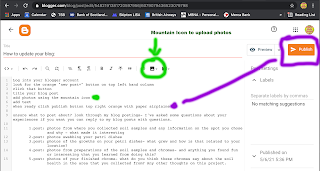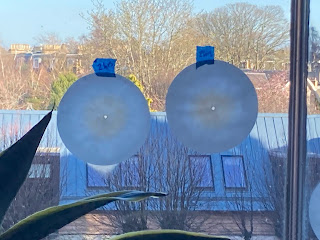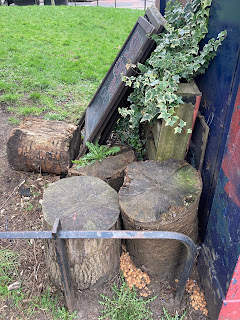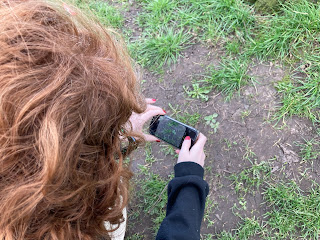Brittonie's SREO Reasearch Blog with James Gillespie's High
Wednesday, September 1, 2021
Public installations... you can access more from my instagram -> stories -> exhibitions
Sunday, June 20, 2021
ALL the AMAZING Work WE (you students) made!
Monday, June 14, 2021
Cyanotypes Iron and Light
- growing
- making us happy
- printing photographs
this is what the cyanotype looks like after I've washed and dried it. because of the directional lighting from the sun, the sun moving a little and the objects being semi-transparent these pieces of seaglass print in a way that makes them look three dimensional and like they're touching (even though they weren't)
This also shows elements of how different objects have different kinds of 'light transmission' which you all had a chance to experience and experiment with when we did cyanotypes last thursday (june 10)
The two parts of cyanotype chemistry include the word "ferric" which means iron based.
this analogue photography process is one of the earliest and is a non silver based process.
Fun facts we discussed about cyanotype:
the process was invented by british scientist Sir John Herschel who then passed the process on to his friend botanist Anna Atkins who made the worlds first ever photography book "British Algy" of her specimins
the term 'blue print' for archetecture comes from this process and it was origionally created so Herschell didn't have to hand copy out all his science notes- like a proto-photocopier (proto being early or pre dating)
Printing with Silver! (and SO MUCH MUCH MORE)
2 Thursdays ago (June 3rd) we got to actually make things together and managed to somehow magically be gifted a sunny day from the photo gods.
We discussed word suffixes like phobic and philic in relationship to words they were already familiar with and how that related in a science context with chemistry.
We talked more about silver nitrate and silver crystals, how there is a latent image in the darkroom which developer helps grow the crystals big enough so we can see them. We talked about how the visible light spectrum is different wave lengths and how we can see some of them as different colours - we talked about rainbows, prisms and how black and white photo paper makes colours with chemigrams and lumes- not with pigments or dyes but by reflecting back only those wavelengths of colour.
we made our own photography developer using lemon juice and washing soda- then we talked about super addatives (multiplication of effect in phtoochemistry terms) by adding instant coffee.
we made our own fixer using what the origional photographers used- a basic salt that is commonly found for treating water to make it softer for fishtanks and pools.
we talked about fabric dying and using resists referencing Batik and then applied that idea to photo paper and made chemigrams exploring 2 different resists(being liquid-phobic).
we talked about Cliche Verrres and how they are the cross between printmaking, drawing and photography and then made our own which were printed using a solarising technique.
We also found plants and made accelerated lumen prints / or chemi-lumens with the plants the sun and the photochemistry we made.
We talked about the difference between photograms and contact prints
We also finally had you all make your chromas from your soil samples! (i'm really looking forward to seeing some of the photos your teachers took documenting- and yours too if you did take some please make a new blog post and add them).
I've got some snaps of you making things on my instagram here
Thursday, May 6, 2021
How to update your blog:
Friday, April 23, 2021
Silver, Salt and Light:
How soil chromatography connects to the history of photography in Edinburgh and Scotland.
It's worth mentioning here that all the advancement in chemistry and innovation of photography might not be possible (or certainly delayed by who knows how long) if it weren't for a brilliant Scottish Chemist; Elizabeth Fulhame who discovered photoreduction with light, water and metal salts(silver nitrate!) She published An essay on combustion : with a view to a new art of dying and painting. Wherein the phlogistic and antiphlogistic hypotheses are proven erroneous in 1794!
Only four years after the invention of photography was announced to the world in 1839, two Scots had mastered the new medium and were producing works of breathtaking skill in extraordinary quantities.
 |
| Scott Monument on Princess St Edinburgh a salt print made from a calotype. 1843-47 year unkown Monument was completed 1844 |
 |
| Some gentlemen having a nice afternoon. James Ballantyne, Dr George Bell & David Octavius Hill Taken by Adamson with likely help of Mann. |
Monday, April 19, 2021
Soil Chromatography!
So I mixed up all the materials and ingredients for soil chromatography- which you are all going to do this week!
What is Chromatography?
Chromatography understands the soil as a being alive, in other words it is an unfinished process with elements working and living in symbiosis. Therefore the final result is a qualitative view of these processes and elements rather than a quantative one.
Chromatography gives you valuable information such as soil structure, general health of soil, minerals available for the plant, biological diversity, or organic matter content and humus available. It also assess the fertility of the soil through the integration of previous elements.
This is a photographic process using capillary action to make beautiful abstract images which are also science information communication telling us about whats in the soil, and how healthy it is. The main ingredient after soil, water and paper is the Silver Nitrate we use as a sensitiser to make these images.
 |





Some Fun Silver Nitrate (AgNO3) Facts:
Silver Nitrate is used...
- to test the exact salinity of Sea Water. (it’s about 35 grams per Liter, by the way…)
- in Oil Fields to determine the amount of Chloride ions in water and drilling fluids.
- in pharmaceuticals and treating skin and flesh wounds
- to prevent premature shrinking/ dropping of buds & blooms, in cut flowers. (2.83% solution)
- to inhibit cut flowers from making ethylene, which causes them to ripen
- as a stain for proteins and nucleic acids in microscopy
- as a glaze for ceramics (Raku and silver wash)
- as a colourant in glass (blues and purples)
- and
- As a sensitiser in Photography!
Analysis of the Chromatogram or Chroma
The analysis of the final chromatogram - the filter paper - seems more difficult.
Comparison between before and after, different locations, may be easier than to pin-point exactly what is producing the patterns.
The different colours we obtain has to be a reflection of the chemical reaction with silver nitrate and whatever compound that is deposited there.
 |
| this was from sample 1 it reminds me of a tree stump or a turkey tail fungi. What do the ones you've made remind you of? |
The general rule thumb:
- the more complex the pattern the more organic the soil
- the less complex the pattern the less organic the soil
- channels and spikes are a good indication of organic material
- deep strong colours also indicate richer healthier soil
Pfeiffer's Criteria for Evaluation of Chromatograms |
these below are ones i didn't absorb the dirty water long enough and i tried to use different solvents to extract the materials from the soil. I like some of the different things that came from these material experiments- while they might not be as good for the science communication they sure are pretty! This is a great way that science and art overlap- there's a lot of *Experimentation* testing things out, trying different things looking for a result.
Monday, April 12, 2021
Soil Sample Swabs!
Ms. Stewart Sent me some photos of the soil samples!
I'm looking forward to seeing yours!
Make sure to do a blog post about collecting the soil and about your swab discs!
 |
| fungus. Hoping it’ll get furrier. |
Thursday, March 25, 2021
Collecting Soil Samples Action Shots and Edit
these are just the photos I took while collecting soil samples and the red ones are the ones that I'm putting together as an edit. In the same way that I'm posting photos of these activities on my blog- we want you to post your images(photos, drawings or anything else) of soil sample collecting and plate swabbing on your blog. This way I can see what you're doing with the project and leave some feedback for you.
there were also dandelions around so i thought i would document some of the things i saw
then i found this worm, i think its injured. I hope i didn't step on it. :( make sure when you're collecting your samples that you observe health and safety things, consider gloves or if the area you're in is safe to you first, but also try to make sure you're doing no harm to the environment. :)
i found this semi decomposing piece of plastic bag. I decided it was a part of the environment worth documenting. It's not always just nice nature bits- the bag was kind of interesting in its shape and I got an idea for doing more photography with it. I had a spare bag so I picked it up and took it with me.
i found a second location to collect soil samples from. It's closer to the street and had a lot of different elements which i thought were initially visually interesting but also might show some differences in the soil samples. We have some logs, and ivy and iron railing and FUNGI! also a different kind of tree nearby.
environmental shots.
i found this great piece of bark just laying on the ground. I'm going to do some more photography 'studio style' at home. I thought its shape and texture and lines were interesting. I haven't used the rule of thirds in an obvious way here- the object of interest is centred, but there are contrasting textures and elements- the smooth blue grey pavement (man made) and the green and brown textured grass and soil. They make up triangles that divide the image in half but they end at the edges of the top and bottom pretty close to the 'thirds'
landscape and soil collection shot from second location
a close up of that bark again.
another piece of bark with a weird random broken phone cable.... i took that with me too.
i was lucky and had someone help take some photos of me 'in the moment' again documentary action. These can help when describing the process of the science learning, experiment and communicating that later- but also they're part of the art making and learning process.
i like this second one better i think....
just wanted to bring in some more of the environment - the flowers are pretty but they also subtly indicate what time of year it is. We know we usually see these flowers at the beginning of Spring - usually March or early April.
someone getting arty including a different angle and including a perspective that shows more of the tree in an interesting way.
oh loook the spoon is collecting soil which is being captured on my phone! META.
action shot of me taking images showing landscape and texture, foreground and background the leading lines and division help direct the eye to the action while clearly describing the complex environment around.






































































